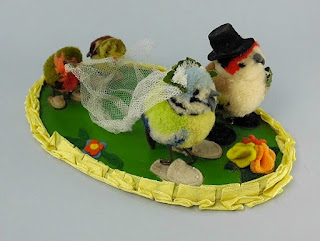 "For 60+ years, this Santa miraculously appeared in the center of the dining room table during every Christmas Eve. Although, as a little girl, I paid particular attention to the goings on, Santa always arrived unannounced as if by magic. By Christmas morning he would be gone, leaving a child’s presents behind. It was the same for my children, and hopefully it will be for theirs.
"For 60+ years, this Santa miraculously appeared in the center of the dining room table during every Christmas Eve. Although, as a little girl, I paid particular attention to the goings on, Santa always arrived unannounced as if by magic. By Christmas morning he would be gone, leaving a child’s presents behind. It was the same for my children, and hopefully it will be for theirs. I have tried to find out more about my Christmas friends, but cannot seem to find a reference other than the Steiff’s Santa himself. There are smaller sleighs, but clearly, this one, with is bridles and sleigh attachments was something quite unusual. The small presents are all wrapped and appear “attached” to the display.
I believe my parents purchased this centerpiece in Germany in the 1950's. We lived in several cities in Germany when I was growing up. I think my mother once suggested that it was in the Steiff shop window as a display piece for Christmas. I think she had to wait until after Christmas to purchase it and then waited the full year to place it in our world.
Might you know more? I would appreciate all that you can tell me about these 60 year old friends. Thank you so very much."
What a wonderful item, with such great family history. Let's first take a look at the two core Steiff items in the piece - the Santa doll and his reindeer.
Santa clearly rules the reins here! This sweet doll is clearly Steiff's earliest post WWII Santa doll. An example is shown here on the left. He is s 31 cm and five ways jointed. Santa has a rubber head; felt body; bright red felt suit, boots, and cap trimmed in white wool plush; and a white fluffy mohair beard. He is self standing and has an amazing resemblance to the jolly man from the north pole! From the collector's perspective, it is interesting to note that Santa's head was created from the same molds and patterns used for Steiff's three lucky dwarfs, Gucki, Lucki, and Pucki. Santa was produced in 13, 18, and 31 cm from 1953 through 1963.
It's time to buck the trend and check out Santa's dear deer. The display features three Steiff's Rehbock or Roebuck. An example of this pattern is shown here on the left. They are each an impressive 35 cm tall, unjointed, and made from tan mohair. They are beautifully airbrushed with golden brown highlights, making them truly handsome beasts. Each also has highlight detailing on his legs, body, and face. All have ears are lined in mohair, white mohair tails, and fabulous felt antlers. Their faces all come to life with black button eyes, a black hand embroidered nose and mouth, and a red accent on their snouts. This pattern was made from 1954 through 1974 in this size only.
So what does this all mean in terms of dating the display? It is Steiffgal's best educated guess, given the configuration of the items pictured and the timeline suggested by the owner, that this was put together around 1954. This the earliest date that both the rubber faced Santa and the large mohair roebucks both appeared in the line. It goes without saying that this is a very attractive showpiece - that is made from relatively standard line toys from the early to mid-1950's.
The sled, decorated and branded harnesses, fittings, and wrapped gifts do look to be Steiff quality and were not produced on a commercial scale. You can see a close up of some of these accessories here on the left. Again, it is Steiffgal's feeling that this display was originally designed by Steiff in
Giengen as a special request window display or focal point for a toy,
department, or other high end store in Germany. And, given its period of production, as well as craftsmanship, is possible that it
was part of a larger animated window display as well.
A few things in the display were not made by Steiff, including some clip-on koala bears, but they were most added on in a loving fashion
over the years to enhance the presentation (most likely from a
youngster's point of view.) It is not clear if some other Steiff items in or on the sled, including a small velvet giraffe, mohair pony, and a small gnome or two, are original to the display or like the clip on koalas, were added in at some point.
It is Steiffgal's understanding that it was not out of the question for stores to sell these elaborate holiday display items post season to special customers. These were not in general available to the public. Or, perhaps it is possible that the current owner had family or a family friend with connections to a store or even a Steiff executive who was able to procure this for her family.
Steiffgal hopes this discussion on this wonderful Christmas family heirloom has put you in a most festive state of mind.
Have a question about one of your Steiff treasures? Let's talk! Click here to learn more.




























